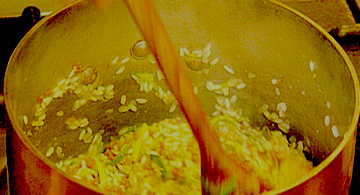
Spring Vegetable Ragù is perfect with toast or Italian-style toast called crostini. Combine the classic ragù technique of making soffritto with your favorite edible symbols of spring – artichokes, asparagus, fava or broad beans, green string beans, peas, leafy greens, and spring onions or scallions. Braise briefly to maintain their flavor and cheery green color.
The types and quantities of vegetables and legumes listed here are guidelines. Fresh vegetables you find in your local market guarantee a ragù possessing the sweetness of spring time. Example, if you love asparagus and peas mixed with baby greens, great! Substitute edamame or baby lima beans for fava or broad beans. For a vegetarian version, saute carrots in place of ham or prosciutto crudo. Add cannellini beans increasing protein, color, and soft texture, if you wish.
Have you noticed how different the first crop or two is from subsequent harvests of the same vegetables? Initial crops are delicate, needing only a hint of garlic to gently infuse them. Adding fresh lemon is the key, so be generous in seasoning with fresh lemon juice and zest. Choose any country-style bread for the toast.
Spring Vegetable Ragù is as delicious as it is nutritious. This mix of fresh vegetables and legumes is packed with protein, minerals, and vitamins. High in dietary fiber, it is a filling dish. Serve with fork and knife as an antipasto with cocktails, a minestra or afternoon snack, or main course.
Cooking time is 25 minutes. Makes 4 cups (946 ml) ragù.
4 to 6 servings
Spring Vegetable Ragù:
Soffritto:
Extra-virgin olive, sunflower, or grapeseed oil
2 spring onions or scallions, thinly sliced
1 leek, white part only thinly sliced
1 small carrot, finely chopped
OR 1/4 cup chopped smoked ham or prosciutto crudo (1 ounce or 28 g)
Finely chopped garlic to taste
Vegetables: In any proportion pleasing to you
4 baby artichokes or 2 large mature artichoke hearts (yields 1 cup or 235 ml volume)
2 lemons
8 thin asparagus spears (yields 1 cup or 235 ml volume)
1 cup fava or broad beans, shucked (1 pound or 455 g pods; about 36 medium-size pods)
1/2 cup green string beans (4 ounces or 115 g; about 12 beans)
1/2 cup green peas, shelled (3 ounces or 85 g shelled; or 12 ounces or 340 g pods; about 24 pods)
1/4 cup (2 ounces or 60 ml) dry white wine
1 cup (8 ounces or 235 ml) vegetable or chicken broth, or water
1 1/2 cups cooked cannellini beans (14 ounces or 400 g can), optional
1 handful leafy greens, such as baby beet greens or spinach
Fresh lemon juice to taste (from 2 lemons above)
Fresh grated lemon zest to taste (from 2 lemons above)
Kosher salt or sea salt to taste
Toast or Crostini:
Country-style bread, sliced
1 garlic clove, split in half
Extra-virgin olive oil
Kosher salt or sea salt to taste
Freshly ground black pepper to taste
Preparation for Spring Vegetable Ragù: It is important to retain the character of some vegetables and legumes by partially cooking them ahead of time. Cook them only to eliminate rawness; do not cook until soft because all ingredients will braise together in the next step. If added to the pan when raw, they require more cooking time, mingling and losing their lovely distinctive flavors, creating a long-cooking stew rather than a fresh-tasting, sprightly ragù.
* Lemons: The 2 lemons provide three different purposes and flavors in this ragù. Grate the zest, cover to prevent it from drying out, and reserve. Split the lemons in half. Squeeze most of the juice into a small glass bowl, cover, and reserve. Use the halves for making acidulated water for the artichokes.
* Artichokes: Fill a bowl with very cold water. Using the lemon halves, squeeze the remaining juice into the water and stir, making it acidulated. Float the lemon halves in the water. Acidulated water helps retard browning on the cut surface of the raw artichokes, so as soon as you slice them, pop them into the water. For edible whole baby artichokes, trim and quarter lengthwise. For large mature artichokes, trim down to the heart then slice. Reserve the edible leaves, cook and use as a trim or garnish for any platter.
* Asparagus: Diagonally cut into short lengths. Blanch in boiling salted water for several seconds. Drain and plunge into cold water or run cold water over to stop the cooking and maintain bright green color. Drain.
* Fava or Broad Beans: Remove from the pods. Blanch in boiling unsalted water for 1 minute. Drain then peel.
* Green String Beans and Peas: Diagonally cut the green string beans into short lengths. Optional for Green String Beans and Peas: Blanch in boiling salted water for several seconds. Drain and plunge into cold water or run cold water over to stop the cooking and maintain bright green color, drain. Or add both raw because they require brief cooking time.
1. The soffritto takes about 10 minutes. Warm the oil in a large non-stick pan over low heat. Saute the spring onions or scallions and leek until softened, about 5 minutes. Add the carrot or ham or prosciutto crudo and saute while stirring for about 4 minutes, without browning. Add the garlic to taste and stir. Create a flavorful foundation with a soft texture and mouth-watering aroma for the ragù.
2. Cooking time is 15 minutes. Meanwhile, remove the lemon halves from the acidulated water, discard the lemon halves or save for another use. Drain the sliced artichokes. Increase the heat to medium. Add the drained artichokes and stir them coating with the soffritto. Simmer for 3 minutes or until the artichokes can be barely pierced with a fork but not falling apart.
Increase the heat to high. Pour in the wine and reduce by half volume without stirring, 1 minute. Add the asparagus, fava or broad beans, beans, and peas. Stir to mix. Pour in the broth or water. Decrease the heat to low-medium, and partially cover the pan. Simmer until the vegetables and legumes cook to the al dente stage, and the juices thicken, 5 to 7 minutes. (If adding cooked cannellini beans, add them during the last few minutes of simmering.)
Remove the pan’s cover. Add the handful of leafy greens and stir. Pour in the reserved fresh lemon juice to taste, add the reserved grated lemon zest to taste, and stir. Simmer for 1 minute. Remove the pan from the heat. Season with salt to taste if needed.
Serving Spring Vegetable Ragù on Toast: Toast or grill slices of bread, then lightly rub the cut side of a garlic clove over the bread while it is very hot. Drizzle with olive oil, season with crunchy coarse salt and ground black pepper – the aroma is luscious! Top with ragù and enjoy every fresh bite of spring time!







